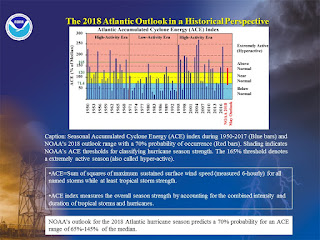We've already provided you with Colorado State University's April Prediction for the Atlantic Basin. NOAA has just released its predictions for the Atlantic Basin, Central and East Pacific regions.
Looking Back and Looking Ahead
Hurricane Season Approaching
Looking Back at 2017
The 2017 Atlantic hurricane season was a hyperactive and catastrophic hurricane season, featuring 17 named storms, 10 hurricanes and 6 major hurricanes – ranking it alongside 1936 as the fifth-most active season since records began in 1851. The season also featured both the highest total accumulated cyclone energy (ACE) and the highest number of major hurricanes since 2005.
In the chart below, the numbers in parenthesis are the averages, so you can easily see that the 2017 Atlantic Hurricane Season was well above average. For more details, read NOAA: Extremely active 2017 Atlantic hurricane season finally ends
Atlantic Basins
| Forecast Parameter and 1950-2000 Climatology (in parentheses) | NOAA 2017 Prediction | 2017 Actual |
| Named Storms (NS) (12.0) | 11 - 17 | 17 |
| Hurricanes (H) (6.5) | 5 - 9 | 10 |
| Major Hurricanes (MH) (2.0) | 2 - 4 | 6 |
| Accumulated Cyclone Energy (ACE) (92.0) | 63 - 103 | 224 |
|
The 2017 Pacific hurricane season was a moderately active Pacific hurricane season, featuring eighteen named storms, nine hurricanes, and four major hurricanes, though the season was significantly less active than the previous three seasons. The season saw near-average activity in terms of ACE, in stark contrast to the extremely active seasons in 2014, 2015, and 2016; and for the first time since 2012, no tropical cyclones formed in the Central Pacific basin. However, for the third year in a row, the season featured above-average activity in July, with the ACE value being the fifth highest for the month.
East Pacific
| Forecast Parameter and 1950-2000 Climatology (in parentheses) | NOAA 2017 Prediction | 2017 Actual |
| Named Storms (NS) (9.6) | 14 - 20 | 18 |
| Hurricanes (H) (5.9) | 6 - 11 | 9 |
| Major Hurricanes (MH) (2.3) | 3 - 7 | 4 |
| Accumulated Cyclone Energy (ACE) (96.1) | 75 - 145 | 100 |
Looking Ahead to 2018
As is customary, the Colorado State University releases its predictions in December and April. See our blog post, 2018 CSU Atlantic Hurricane Prediction, for their 2018 predictions.
Atlantic Basin
Forecasters predict a 35 percent chance of an above-normal season, a 40 percent chance of a near-normal season, and a 25 percent chance of a below-normal season for the upcoming hurricane season, which extends from June 1 to November 30.
 |
| (click images to enlarge) Credit NOAA |
 |
| Worldwide Tropical Cyclone Name (click link) |
NOAA’s forecasters predict a 70-percent likelihood of 10 to 16 named storms (winds of 39 mph or higher), of which 5 to 9 could become hurricanes (winds of 74 mph or higher), including 1 to 4 major hurricanes (category 3, 4 or 5; with winds of 111 mph or higher). An average hurricane season produces 12 named storms, of which 6 become hurricanes, including 3 major hurricanes.
East Pacific
An 80 percent chance of a near- or above-normal season is predicted for both the eastern and central Pacific regions. The eastern Pacific outlook calls for a 70-percent probability of 14 to 20 named storms, of which 7 to 12 are expected to become hurricanes, including 3 to 7 major hurricanes. Central Pacific
An important measure of the total overall seasonal activity is the NOAA Accumulated Cyclone Energy (ACE) index, which accounts for the intensity and duration of named storms and hurricanes during the season. According to NOAA’s hurricane season classifications,
an ACE value above 117% of the 1950-2000 median reflects an
above-normal season. An ACE value above 175% of the median reflects an
exceptionally active (or hyperactive) season.
Hurricane Season Dates

Hurricane season in the Atlantic begins June 1st and ends November 30th. The Eastern Pacific hurricane season begins May 15th and also ends November 30th.
Make a Plan (FEMA)
 |
| Read entire series (click here) |
More links and information about tropical storms and other weather conditions can be found in the Weather & Hurricane Zone tabs above.
Hurricane Preparedness Week:
May 6-12, 2018

Sign-up for Exclusive Email Offers






No comments:
Post a Comment